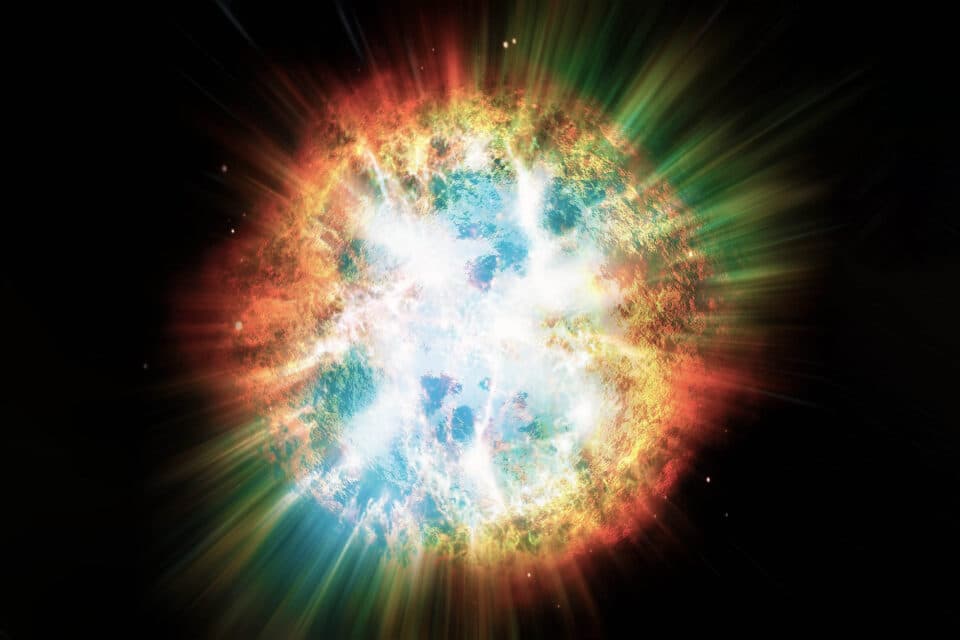
Blaze Star: Huge stellar explosion will be visible from Earth for a week
For the first time in eight decades, a celestial phenomenon will grace our night sky, offering a once-in-a-lifetime chance to witness a star’s brilliance with the naked eye during a dramatic explosion.
Known as T Coronae Borealis, or T CrB, this star resides 3,000 light-years from Earth in the Northern hemisphere’s expanse and is on the brink of an intense outburst.
Star explosion in the Corona Borealis constellation
This event, set to occur this year, will see T CrB lighting up the Corona Borealis constellation, shining as brightly as the famed North Star, Polaris, for approximately one week.
Corona Borealis, also known as the Northern Crown, is a small constellation located in the northern celestial hemisphere. It contains a semicircular arc of stars that resemble a crown.
The brightest star in the constellation is called Alphecca or Gemma, which is an eclipsing binary star system.
T CrB, the recurring nova located within the Corona Borealis constellation, consists of a white dwarf and a red giant star orbiting each other closely. The white dwarf siphons matter from the red giant, causing occasional outbursts that significantly increase the system’s brightness.
T CrB is nestled within the Corona Borealis constellation, lying in a semicircular pattern between the Bootes and Hercules constellations.
The exact timing of this stellar spectacle remains uncertain, with NASA forecasting its occurrence sometime between now and September.
Rare astronomical event
The imminent outburst, classified as a nova, represents a rare astronomical event that unfolds roughly every century.
It happens when a white dwarf star — comparable in size to the sun but collapsed – and a red giant star — nearing the end of its life and expanding to about 74 times the sun’s size – venture too close to each other.
This proximity dramatically raises the red giant’s surface temperature from about 4,000 to 5,800 degrees Fahrenheit to an astonishing 360,000 degrees Fahrenheit, prompting T CrB to expel its outer layers onto the white dwarf’s surface.
Enormous thermonuclear explosion
The culmination of matter from the red giant triggers a nuclear explosion, unleashing an energy burst up to 100,000 times greater than the sun’s annual output.
Unlike a supernova, which obliterates the star, a nova such as T CrB’s does not destroy the star system. Instead, the star cools down to its original temperature and restarts its cycle.
Previous explosions of T CrB
Historical records trace T CrB’s notable eruptions back to 1946 and even 1866, with earlier accounts suggesting observations several centuries ago.
Notably, Reverend Francis Wollaston in 1787 and Abbott Burchard in 1217 documented witnessing a bright star in the Corona Borealis constellation, hinting at earlier appearances of T CrB.
Brief yet intense display
This particular star explosion is unique for its brief yet intense display, completing its cycle in merely a week.
NASA anticipates that the nova’s peak brightness will allow it to be visible to the naked eye for several days, and with binoculars for just over a week, before it fades away, potentially not to reappear for another 80 years.
This upcoming event invites sky enthusiasts and the curious alike to marvel at the wonders of our universe, showcasing the ephemeral yet awe-inspiring nature of celestial phenomena.
More about T Coronae Borealis (T CrB)
As discussed above, T Coronae Borealis (T CrB), often termed the ‘Blaze Star,’ is a captivating binary star system located in the constellation Corona Borealis.
This astronomical wonder stands out due to its explosive behavior — it’s a recurrent nova system. Comprising a red giant and a white dwarf, T Coronae Borealis periodically lights up the night sky with its dramatic outbursts.
The phenomenon occurs when the white dwarf, a dense remnant of a star that has exhausted its nuclear fuel, draws material from its companion red giant.
As this material accumulates on the white dwarf’s surface, it eventually triggers a thermonuclear explosion. This process causes the system to dramatically increase in brightness, making it visible even to observers on Earth with the naked eye.
Enigmatic white dwarfs
Central to the spectacle of T Coronae Borealis is the white dwarf, a stellar remnant that offers profound insights into the life cycles of stars.
White dwarfs are the end products of stars that originally had masses up to eight times that of the Sun but ended their lives in a relatively peaceful manner, without exploding as supernovae.
These stellar cores are fascinating for several reasons:
- Density and Composition: Despite their diminutive size, white dwarfs are incredibly dense. Their mass is comparable to that of the Sun, but they have a volume similar to Earth’s. This high density arises because the matter within them is in a degenerate state, where electrons are packed closely together.
- Cooling Process: After their formation, white dwarfs embark on a long cooling process. They start out extremely hot but gradually radiate away their heat over billions of years, eventually fading into black dwarfs — theoretical objects that have not yet been observed because the universe is not old enough.
- Limiting Mass: The Chandrasekhar limit, approximately 1.4 times the mass of the Sun, defines the maximum mass a white dwarf can have. Beyond this limit, the star would collapse under its own gravity to form a neutron star or a black hole.
Window into cosmic evolution
In summary, the study of T Coronae Borealis and white dwarfs opens a window into the complex processes governing stellar evolution.
By observing these celestial phenomena, scientists gain valuable insights into the life cycles of stars, the dynamics of binary star systems, and the ultimate fate of our own Sun.
As observers on Earth, witnessing the dramatic eruptions of T Coronae Borealis or understanding the nature of white dwarfs connects us more deeply with the cosmos.
These celestial events and objects remind us of the dynamic universe we inhabit, where stars are born, live out their lives, and meet their end in spectacular fashion.
Differences between nova and supernova explosions
The cosmos is a stage for some of the most spectacular and powerful events known to science. Among these, nova and supernova explosions stand out for their brilliance and the fundamental roles they play in the universe’s lifecycle.
Despite the similarity in their names, novae and supernovae differ vastly in their origins, mechanisms, and consequences. This article demystifies these cosmic phenomena, highlighting their distinct characteristics.
What is a nova?
As discussed above, a nova occurs in a binary star system, where a white dwarf and a companion star orbit closely. The white dwarf, a dense remnant of a star that has exhausted its nuclear fuel, pulls material — primarily hydrogen — from its companion.
This material accumulates on the white dwarf’s surface, eventually igniting in a thermonuclear explosion. The explosion causes the white dwarf to brighten significantly, but it does not result in the star’s destruction. Instead, the process may repeat if the white dwarf continues to accrete material.
What is a supernova?
In contrast, a supernova is a cataclysmic event marking the death of a star. Supernovae can occur in one of two primary ways:
Core-Collapse Supernova: This type happens at the end of a massive star’s life cycle. When the star’s core runs out of nuclear fuel, it can no longer support the outer layers against gravity. The core collapses, resulting in a massive explosion that obliterates the star.
Type Ia Supernova: This type involves a binary system where a white dwarf accretes material from a companion star, similar to a nova. However, in this case, the white dwarf reaches a critical mass (Chandrasekhar limit), leading to a runaway nuclear reaction that completely destroys the white dwarf.
Key differences between novae and supernovae
Scale and Energy
The most striking difference lies in their scale and the energy released. Supernovae are among the universe’s most energetic events, outshining entire galaxies and releasing vast amounts of energy. Novae, while still bright and powerful, are far less energetic and only cause a temporary increase in brightness.
Frequency and Visibility
Supernovae are relatively rare events, occurring about once every 50 years in a galaxy the size of the Milky Way. Novae, on the other hand, are more common, with several occurring in our galaxy each year. Despite their rarity, supernovae can often be seen from greater distances due to their immense brightness.
Outcome
A supernova marks the end of a star’s life, often leaving behind a neutron star or black hole. The explosion disperses the star’s material into space, contributing to the cosmos’s chemical enrichment.
A nova does not destroy the white dwarf. Instead, it merely expels the outer layers of accumulated material, allowing the process to potentially repeat.
Contribution to the Cosmos
Both phenomena play significant roles in the cosmic lifecycle. Supernovae are crucial for distributing elements necessary for life throughout the universe, while novae contribute to the understanding of stellar processes and the dynamics of binary star systems.
In summary, though novae and supernovae might be mistaken for similar phenomena due to their names and explosive nature, they are fundamentally different in their origins, mechanisms, and implications for the cosmos. Understanding these differences enriches our knowledge of the universe and underscores the vast and varied processes that govern the lifecycle of stars.
—–
Like what you read? Subscribe to our newsletter for engaging articles, exclusive content, and the latest updates.
Check us out on EarthSnap, a free app brought to you by Eric Ralls and Earth.com.
—–












